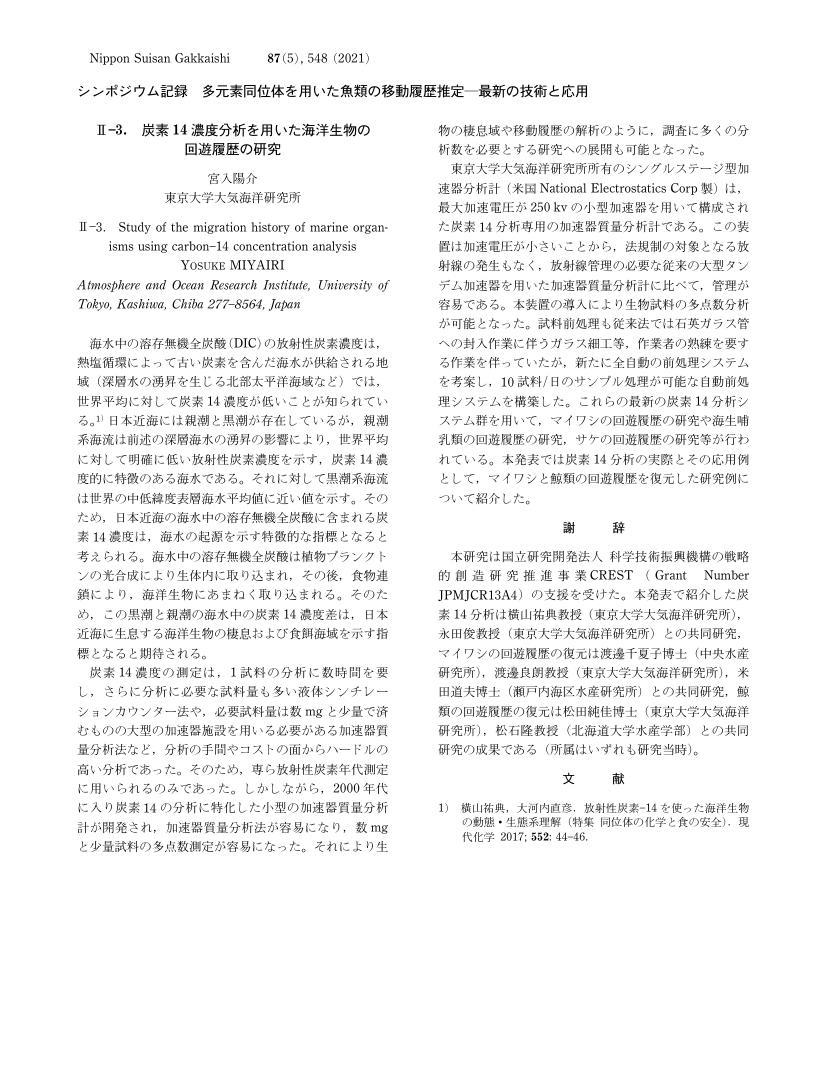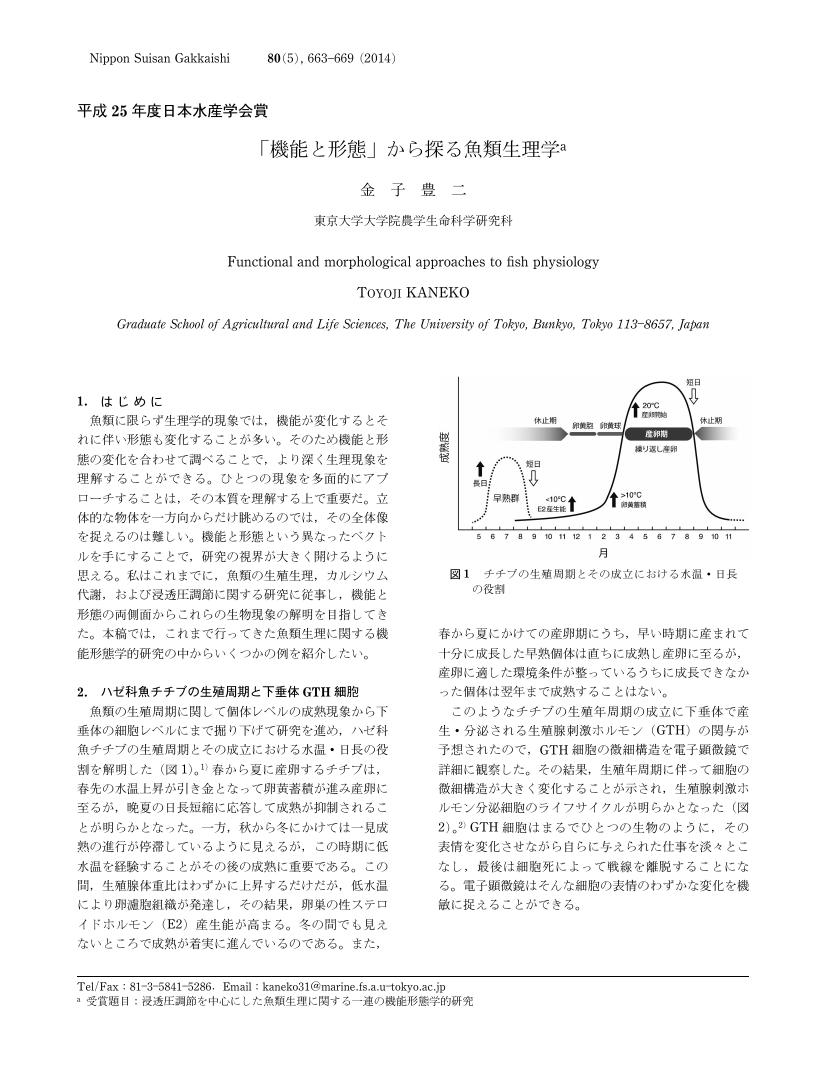- 著者
- 藤永 克昭 尾山 康隆
- 出版者
- 公益社団法人 日本水産学会
- 雑誌
- 日本水産学会誌 (ISSN:00215392)
- 巻号頁・発行日
- vol.73, no.2, pp.256-262, 2007 (Released:2007-04-03)
- 参考文献数
- 28
- 被引用文献数
- 1 1
2000 年 4 月から 2001 年 4 月にかけて,北海道のえりもにおいてエゾボラの繁殖を,成熟サイズ,生殖周期や性比の点から検討した。エゾボラの成熟サイズは,雄は殻高 120~130 mm,雌は殻高 150~160 mm であると判断された。エゾボラの主な交尾時期は,2 月から 5 月にかけてであると考えられた。一方,エゾボラの産卵は,3 月から 8 月にかけて行われると推測された。エゾボラの性比は季節によって変化した。エゾボラの殻高組成は雌雄によって相違し,その原因として雌雄の成長の差以外に,雄と雌の死亡率の相違による可能性も考えられた。
- 著者
- 立原 一憲 木村 清朗
- 出版者
- 日本水産學會
- 雑誌
- 日本水産学会誌 (ISSN:00215392)
- 巻号頁・発行日
- vol.54, no.7, pp.1107-1113, 1988
- 被引用文献数
- 1 4
A study on the life history of land-locked ayu <i>Plecoglossus altivelis</i> was made in Lake Ikeda, Kagoshima Prefecture, from 1981 to 1986.<br>Like amphidromous ayu, the life span of the land-locked fish in this lake is usually only one year and most of them die after spawning in autumn. However, a few individuals of land-locked ayu passing over the second winter are found in the lake.<br>The specimens counting 7, 810 of ayu in the lake were collected during this study and 73 of them were thought to be the over-wintered ones, because they had a conspicuous spawning mark on the embeded part of their scales. None of 0<sup>+</sup> fish had any such scales. The amounts of fat tissue around viscera of mature ayu decreased in the spawning season from early October to late Novermber. Also, the condition factor of ayu caught in November showed very wide range from 0.6 to 1.7. The fish whose condition factor was less than 0.9 had exteremely shrunk stomach without any food, whereas the fish of more than 1.3 in condition factor had normal stomach containing a small amounts of diatoms and blue-green algae. All specimens of 1<sub>+</sub> fish, which were collected after December, had recovered their fat tissue and begun to grow again. Thus, it is suggested that the survival of ayu after spawning season depends on the degree of stomach shrinkage and adequate intake of food. Some of them grew 150mm in standard length or more by the next autumn.<br>The specimens of mature 1<sup>+</sup> fish which were caught at a spawning ground in October suggests that some of the over-wintered ayu in the lake are able to attain maturity in second spawning season.
1 0 0 0 広島県太田川における越年アユの生物学的, 生化学的性状
- 著者
- 栄 研二 海野 徹也 高原 泰彦 荒井 克俊 中川 平介
- 出版者
- 日本水産學會
- 雑誌
- 日本水産学会誌 (ISSN:00215392)
- 巻号頁・発行日
- vol.62, no.1, pp.46-50, 1996-01-15
- 参考文献数
- 14
- 被引用文献数
- 2
Yearling ayu <i>Plecoglossus altivelis</i> collected in June and July from the Ohta River were biologically and biochemically examined in comparison with annual ayu caught in the same area.<br>All the yearling ayu were female. The yearlng ayu were different in size and skin color from the annual ayu, but not different in anatomical parameters such as hepatosomatic index, intraperitoneal fat body ratio, and gonadosomatic index. The ovaries of annual ayu were immature and included chromatin nucleolus and perinucleolus stage eggs, but those of yearling ayu consisted mostly of abortive eggs and a few chromatin nucleolus and perinucleolus stage eggs.<br>The yearling ayu had less muscle protein but more triglycerides than annual ayu. Fatty acid composition of muscle triglycerides in the yearling ayu was not different from that of the annual ayu. Low protein accumulation caused by depression of protein metabolism would affect the viability of yearling ayu after July.
1 0 0 0 OA Ⅱ-3. 炭素14濃度分析を用いた海洋生物の回遊履歴の研究
- 著者
- 宮入 陽介
- 出版者
- 公益社団法人 日本水産学会
- 雑誌
- 日本水産学会誌 (ISSN:00215392)
- 巻号頁・発行日
- vol.87, no.5, pp.548, 2021-09-15 (Released:2021-10-01)
- 参考文献数
- 1
1 0 0 0 OA 池田湖産陸封アユの卵内発生と仔・稚魚の成長に伴う形態変化
1 0 0 0 OA 里海と魚つき林
- 著者
- 若菜 博
- 出版者
- 公益社団法人 日本水産学会
- 雑誌
- 日本水産学会誌 (ISSN:00215392)
- 巻号頁・発行日
- vol.79, no.6, pp.1034-1036, 2013 (Released:2013-11-18)
- 参考文献数
- 8
1 0 0 0 OA 「機能と形態」から探る魚類生理学
- 著者
- 金子 豊二
- 出版者
- 公益社団法人 日本水産学会
- 雑誌
- 日本水産学会誌 (ISSN:00215392)
- 巻号頁・発行日
- vol.80, no.5, pp.663-669, 2014 (Released:2014-10-01)
- 参考文献数
- 20
1 0 0 0 OA クルマエビの急性ウイルス血症
- 著者
- 中野 平二
- 出版者
- 公益社団法人 日本水産学会
- 雑誌
- 日本水産学会誌 (ISSN:00215392)
- 巻号頁・発行日
- vol.71, no.4, pp.639-644, 2005 (Released:2005-08-24)
- 参考文献数
- 5
- 被引用文献数
- 1 1
- 著者
- 岩崎 敬二
- 出版者
- 公益社団法人日本水産学会
- 雑誌
- 日本水産学会誌 (ISSN:00215392)
- 巻号頁・発行日
- vol.73, no.6, pp.1121-1124, 2007-11-15
- 被引用文献数
- 3
1 0 0 0 OA 温泉水を用いた閉鎖循環型トラフグ養殖システムの開発
- 著者
- 野口 勝明
- 出版者
- 公益社団法人 日本水産学会
- 雑誌
- 日本水産学会誌 (ISSN:00215392)
- 巻号頁・発行日
- vol.83, no.5, pp.750-753, 2017 (Released:2017-09-20)
- 参考文献数
- 16
- 被引用文献数
- 2
- 著者
- 平山 和次 渡辺 剛志
- 出版者
- 日本水産學會
- 雑誌
- 日本水産学会誌 (ISSN:00215392)
- 巻号頁・発行日
- vol.39, no.11, pp.1129-1133, 1973
- 被引用文献数
- 36
The nutritional effect of caked yeast still living and of dried marine yeast on the rotifer, <i>Brachionus plicatilis</i>, was examined.<br> Experiments were performed by culturing many individuals in many test tubes, each containing two individuals in the experimental medium. From daily counts of eggs laid and surviving individuals, time intervals from hatching to 50% survival and to peak of fecundity, net reproduction rate, intrinsic rate of population increase and mean generation time were estimated.<br> The results obtained are summarized as follows.<br> 1. Caked yeast still living, <i>Rhodotorula sp.</i> has less nutritional effect on the rotifer than that of the marine <i>Chlorella.</i> However, it seems to be somewhat effective as food for the rotifer.<br> 2. Dried marine yeast itself has little nutritional effect on the rotifer. However, aerobical decomposition can increase the nutritional effect to some extent.<br> 3. The marine yeast added to a diluted <i>Chlorella</i> suspension was very effective as supplementary food for the rotifer. Hence, yeast may be used most effectively as a sup-plementary food in the culture medium when sufficient phytoplankton can not be supplied to the rotifer.
1 0 0 0 OA イシダイ仔稚魚の成長に伴う視力の変化
1 0 0 0 OA 海底に長期間浸漬した刺網の漁獲機能の経時変化
海底に残置された逸失刺網の漁獲継続期間について検討するため、千葉県館山湾の海底に刺網を2000日間浸漬し、浸漬時間と羅網個体数の関係を調べた。刺網にはイセエビ15個体、イセエビ以外の甲殻類25個体、腹足類8個体、魚類5個体、その他2個体の合計55個体が羅網した。羅網個体数は実験開始直後に急増し、浸漬11日目に最大となった後、減少した。羅網個体数の減少過程は指数関数で表され、漁獲継続期間は182日と推定された。漁獲継続期間はイセエビや魚類では短く、イセエビ以外の甲殻類や腹足類ではより長期に及んだ。
1 0 0 0 逸失した状態におけるベニズワイガニ籠のサイズ選択性
- 著者
- 渡部 俊広 TOSHIHIRO WATANABE (独)水産総合研究センター水産工学研究所漁業生産工学部 Fishing Technology Division National Research Institute of Fisheries Engineering Fisheries Research Agency
- 出版者
- 日本水産學會
- 雑誌
- 日本水産学会誌 (ISSN:00215392)
- 巻号頁・発行日
- vol.71, no.1, pp.16-23, 2005-01-15
- 参考文献数
- 32
- 被引用文献数
- 9 9
隠岐諸島西方の海域で,商業ベニズワイガニ籠と円形脱出口をつけた商業籠による長期浸漬(約 6 ヶ月間)漁獲試験を行い,逸失時の商業籠の漁獲サイズ選択性を推定した.選択性曲線は,多項分布の尤度を用いた SELECT モデルによって求めた.商業籠の 50% 選択甲幅は 100.8 mm,選択性スパンは 3.4 mm であった.甲幅 99 mm 以下の個体は,商業籠から脱出できるため,雌についてはゴーストフィッシングが生じる可能性はない.しかし,籠に入った甲幅 103 mm 以上の雄については,籠内に保持されたまま死亡する可能性がある.<br>
1 0 0 0 OA 逸失底刺網のゴーストフィッシング能力の経時的変化と死亡数推定
逸失底刺網のゴーストフィッシング(GF)の経時的変化と死亡数の定量的評価を試みた。模擬逸失網の連続2日の潜水観察で罹網魚/日を調べる実験を当初は毎日、以後は間隔をおいて最長1689日間、計3回行った。網周辺の魚類相の定常性を確認し、罹網数の変化は網のGF能力の変化を代表すると考えた。GF能力低下をその短期・長期的要因による2項の和で近似し、GF継続期間(GF能力が当初の5%になるまで)を142日、総死亡数を455尾と推定した。マダイ、ムロアジはおもに初期の短期間、カワハギは長期間罹網が生じた。
1 0 0 0 海底に長期間浸漬した刺網の漁獲機能の経時変化
- 著者
- 秋山 清二
- 出版者
- 日本水産學會
- 雑誌
- 日本水産學會誌 = Bulletin of the Japanese Society of Scientific Fisheries (ISSN:00215392)
- 巻号頁・発行日
- vol.76, no.5, pp.905-912, 2010-09-15
- 参考文献数
- 21
- 被引用文献数
- 1 1
海底に残置された逸失刺網の漁獲継続期間について検討するため,千葉県館山湾の海底に刺網を 2000 日間浸漬し,浸漬時間と羅網個体数の関係を調べた。刺網にはイセエビ 15 個体,イセエビ以外の甲殻類 25 個体,腹足類 8 個体,魚類 5 個体,その他 2 個体の合計 55 個体が羅網した。羅網個体数は実験開始直後に急増し,浸漬 11 日目に最大となった後,減少した。羅網個体数の減少過程は指数関数で表され,漁獲継続期間は 182 日と推定された。漁獲継続期間はイセエビや魚類では短く,イセエビ以外の甲殻類や腹足類ではより長期に及んだ。<br>
- 著者
- 後藤 友明
- 出版者
- 日本水産學會
- 雑誌
- 日本水産學會誌 = Bulletin of the Japanese Society of Scientific Fisheries (ISSN:00215392)
- 巻号頁・発行日
- vol.78, no.6, pp.1187-1189, 2012-11-15
- 参考文献数
- 9
- 被引用文献数
- 3
東日本大震災により岩手県地先の沿岸域に放置された底刺網 4 張りを回収し,漁具の状態とゴーストフィッシングの実態を評価した。回収された漁具は,設置位置からの大きな移動は認められなかったが,多くの付着物や網成りの低下が見られていた。回収された刺網によってカレイ類とカジカ類が優占する魚類と甲殻類が合計 10 種 55 個体・8,717 g 採集された。漁具間の罹網個体数に差は認められず,震災からおよそ 3 ヶ月経過した回収時においてもカレイ類やカジカ類を中心とする底魚類の罹網と死亡が繰り返されていることが示唆された。<br>
1 0 0 0 OA 東日本大震災で岩手県沿岸域に放置された底刺網の状態とゴーストフィッシングの実態
東日本大震災により岩手県地先の沿岸域に放置された底刺網4張りを回収し,漁具の状態とゴーストフィッシングの実態を評価した。回収された漁具は,設置位置からの大きな移動は認められなかったが,多くの付着物や網成りの低下が見られていた。回収された刺網によってカレイ類とカジカ類が優占する魚類と甲殻類が合計10種55個体・8,717g採集された。漁具間の罹網個体数に差は認められず,震災からおよそ3ヶ月経過した回収時においてもカレイ類やカジカ類を中心とする底魚類の罹網と死亡が繰り返されていることが示唆された。
1 0 0 0 ゴーストフィッシングとは
- 著者
- 松岡 達郎 TATSURO MATSUOKA 鹿児島大学水産学部 Faculty of Fisheries Kagoshima University
- 出版者
- 公益社団法人 日本水産学会
- 雑誌
- 日本水産学会誌 (ISSN:00215392)
- 巻号頁・発行日
- vol.72, no.5, pp.928-929, 2006-09-15
- 参考文献数
- 12
- 被引用文献数
- 1
1 0 0 0 OA 逸失した状態におけるベニズワイガニ篭のサイズ選択性
隠岐諸島西方の海域で、商業ベニズワイガニ籠と円形脱出口をつけた商業籠による長期浸漬(約6ヵ月間)漁業試験を行い、逸失時の商業籠の漁獲サイズ選択性を推定した。選択性曲線は、多項分布の尤度を用いたSELECモデルによって求めた。商業籠の50%選択甲幅は100.8mm、選択性スパンは3.4mmであった。甲幅99mm以下の個体は、商業籠から脱出できるため、雌についてはゴーストフィッシングが生じる可能性はない。しかし、籠に入った甲幅103mm以上の雄については、籠内に保持されたまま死亡する可能性がある。





